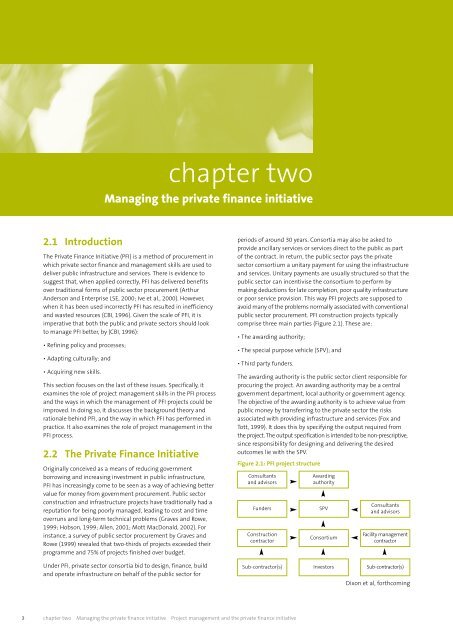Project management and the private finance initiative
Project management and the private finance initiative
Project management and the private finance initiative
You also want an ePaper? Increase the reach of your titles
YUMPU automatically turns print PDFs into web optimized ePapers that Google loves.
2.1 Introduction<br />
chapter two<br />
Managing <strong>the</strong> <strong>private</strong> <strong>finance</strong> <strong>initiative</strong><br />
The Private Finance Initiative (PFI) is a method of procurement in<br />
which <strong>private</strong> sector <strong>finance</strong> <strong>and</strong> <strong>management</strong> skills are used to<br />
deliver public infrastructure <strong>and</strong> services. There is evidence to<br />
suggest that, when applied correctly, PFI has delivered benefits<br />
over traditional forms of public sector procurement (Arthur<br />
Anderson <strong>and</strong> Enterprise LSE, 2000; Ive et al., 2000). However,<br />
when it has been used incorrectly PFI has resulted in inefficiency<br />
<strong>and</strong> wasted resources (CBI, 1996). Given <strong>the</strong> scale of PFI, it is<br />
imperative that both <strong>the</strong> public <strong>and</strong> <strong>private</strong> sectors should look<br />
to manage PFI better, by (CBI, 1996):<br />
• Refining policy <strong>and</strong> processes;<br />
• Adapting culturally; <strong>and</strong><br />
• Acquiring new skills.<br />
This section focuses on <strong>the</strong> last of <strong>the</strong>se issues. Specifically, it<br />
examines <strong>the</strong> role of project <strong>management</strong> skills in <strong>the</strong> PFI process<br />
<strong>and</strong> <strong>the</strong> ways in which <strong>the</strong> <strong>management</strong> of PFI projects could be<br />
improved. In doing so, it discusses <strong>the</strong> background <strong>the</strong>ory <strong>and</strong><br />
rationale behind PFI, <strong>and</strong> <strong>the</strong> way in which PFI has performed in<br />
practice. It also examines <strong>the</strong> role of project <strong>management</strong> in <strong>the</strong><br />
PFI process.<br />
2.2 The Private Finance Initiative<br />
Originally conceived as a means of reducing government<br />
borrowing <strong>and</strong> increasing investment in public infrastructure,<br />
PFI has increasingly come to be seen as a way of achieving better<br />
value for money from government procurement. Public sector<br />
construction <strong>and</strong> infrastructure projects have traditionally had a<br />
reputation for being poorly managed, leading to cost <strong>and</strong> time<br />
overruns <strong>and</strong> long-term technical problems (Graves <strong>and</strong> Rowe,<br />
1999; Hobson, 1999; Allen, 2001; Mott MacDonald, 2002). For<br />
instance, a survey of public sector procurement by Graves <strong>and</strong><br />
Rowe (1999) revealed that two-thirds of projects exceeded <strong>the</strong>ir<br />
programme <strong>and</strong> 75% of projects finished over budget.<br />
Under PFI, <strong>private</strong> sector consortia bid to design, <strong>finance</strong>, build<br />
<strong>and</strong> operate infrastructure on behalf of <strong>the</strong> public sector for<br />
3 chapter two Managing <strong>the</strong> <strong>private</strong> <strong>finance</strong> <strong>initiative</strong> <strong>Project</strong> <strong>management</strong> <strong>and</strong> <strong>the</strong> <strong>private</strong> <strong>finance</strong> <strong>initiative</strong><br />
periods of around 30 years. Consortia may also be asked to<br />
provide ancillary services or services direct to <strong>the</strong> public as part<br />
of <strong>the</strong> contract. In return, <strong>the</strong> public sector pays <strong>the</strong> <strong>private</strong><br />
sector consortium a unitary payment for using <strong>the</strong> infrastructure<br />
<strong>and</strong> services. Unitary payments are usually structured so that <strong>the</strong><br />
public sector can incentivise <strong>the</strong> consortium to perform by<br />
making deductions for late completion, poor quality infrastructure<br />
or poor service provision. This way PFI projects are supposed to<br />
avoid many of <strong>the</strong> problems normally associated with conventional<br />
public sector procurement. PFI construction projects typically<br />
comprise three main parties (Figure 2.1). These are:<br />
• The awarding authority;<br />
• The special purpose vehicle (SPV); <strong>and</strong><br />
• Third party funders.<br />
The awarding authority is <strong>the</strong> public sector client responsible for<br />
procuring <strong>the</strong> project. An awarding authority may be a central<br />
government department, local authority or government agency.<br />
The objective of <strong>the</strong> awarding authority is to achieve value from<br />
public money by transferring to <strong>the</strong> <strong>private</strong> sector <strong>the</strong> risks<br />
associated with providing infrastructure <strong>and</strong> services (Fox <strong>and</strong><br />
Tott, 1999). It does this by specifying <strong>the</strong> output required from<br />
<strong>the</strong> project. The output specification is intended to be non-prescriptive,<br />
since responsibility for designing <strong>and</strong> delivering <strong>the</strong> desired<br />
outcomes lie with <strong>the</strong> SPV.<br />
Figure 2.1: PFI project structure<br />
Consultants<br />
<strong>and</strong> advisors<br />
Awarding<br />
authority<br />
Funders SPV<br />
Construction<br />
contractor<br />
Consortium<br />
Consultants<br />
<strong>and</strong> advisors<br />
Facility <strong>management</strong><br />
contractor<br />
Sub-contractor(s) Investors Sub-contractor(s)<br />
Dixon et al, forthcoming

















